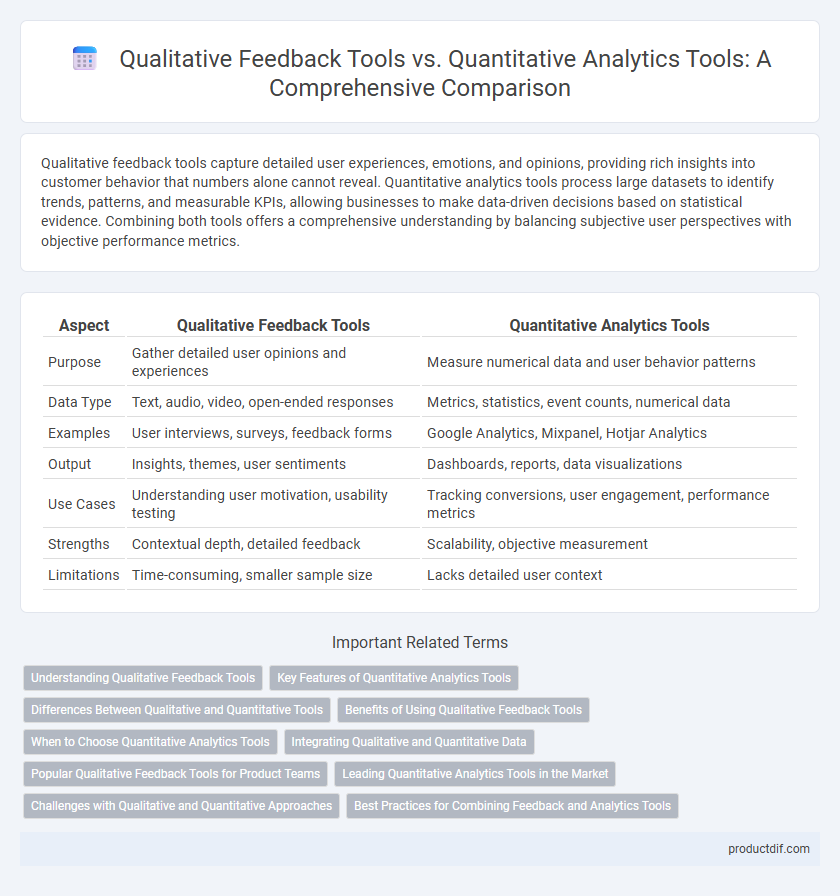Qualitative feedback tools capture detailed user experiences, emotions, and opinions, providing rich insights into customer behavior that numbers alone cannot reveal. Quantitative analytics tools process large datasets to identify trends, patterns, and measurable KPIs, allowing businesses to make data-driven decisions based on statistical evidence. Combining both tools offers a comprehensive understanding by balancing subjective user perspectives with objective performance metrics.
Table of Comparison
| Aspect | Qualitative Feedback Tools | Quantitative Analytics Tools |
|---|---|---|
| Purpose | Gather detailed user opinions and experiences | Measure numerical data and user behavior patterns |
| Data Type | Text, audio, video, open-ended responses | Metrics, statistics, event counts, numerical data |
| Examples | User interviews, surveys, feedback forms | Google Analytics, Mixpanel, Hotjar Analytics |
| Output | Insights, themes, user sentiments | Dashboards, reports, data visualizations |
| Use Cases | Understanding user motivation, usability testing | Tracking conversions, user engagement, performance metrics |
| Strengths | Contextual depth, detailed feedback | Scalability, objective measurement |
| Limitations | Time-consuming, smaller sample size | Lacks detailed user context |
Understanding Qualitative Feedback Tools
Qualitative feedback tools capture user experiences, opinions, and emotions through open-ended responses, interviews, or focus groups, offering rich, detailed insights that quantitative analytics cannot provide. These tools help identify user motivations and pain points by analyzing textual or verbal data, enabling product teams to uncover deeper behavioral patterns. Understanding qualitative feedback tools is essential for improving user satisfaction and driving innovation based on subjective user perspectives.
Key Features of Quantitative Analytics Tools
Quantitative analytics tools offer robust data collection capabilities, enabling precise measurement of user behaviors through metrics like click rates, session duration, and conversion rates. These tools utilize statistical analysis and visualization techniques to identify patterns and trends, supporting data-driven decision-making with large datasets. Integration with multiple data sources and real-time reporting are key features that enhance their effectiveness in optimizing product performance and user experience.
Differences Between Qualitative and Quantitative Tools
Qualitative feedback tools gather subjective insights through open-ended responses, interviews, and observations, focusing on user emotions, motivations, and experiences. Quantitative analytics tools capture numerical data such as click rates, conversion metrics, and usage statistics to identify patterns and measure performance objectively. These differences highlight qualitative tools' strength in depth and context, while quantitative tools excel in scalability and statistical analysis.
Benefits of Using Qualitative Feedback Tools
Qualitative feedback tools capture detailed user experiences and emotions, providing rich insights into customer needs and product improvements. These tools enable businesses to understand the "why" behind user behavior, uncovering nuanced information that quantitative analytics may miss. Leveraging qualitative data enhances customer satisfaction by informing more personalized and effective decision-making processes.
When to Choose Quantitative Analytics Tools
Quantitative analytics tools excel in processing large datasets to identify patterns, trends, and measurable outcomes, making them ideal for performance tracking and data-driven decision-making. These tools are best chosen when precise numerical data is required to evaluate user behavior, conversion rates, or market trends at scale. Organizations prioritize quantitative tools when their goal is to generate statistically significant insights that support forecasting and optimization strategies.
Integrating Qualitative and Quantitative Data
Integrating qualitative feedback tools with quantitative analytics tools enables a comprehensive understanding of user behavior by combining narrative insights with numerical data patterns. This fusion allows businesses to validate user sentiments through metrics such as Net Promoter Score (NPS) and conversion rates, enhancing decision-making accuracy. Leveraging platforms like Hotjar or Qualtrics alongside Google Analytics facilitates a holistic analysis that drives product improvements and customer satisfaction.
Popular Qualitative Feedback Tools for Product Teams
Popular qualitative feedback tools for product teams include UserTesting, Lookback, and Hotjar, which provide in-depth insights through user interviews, session recordings, and surveys. These tools help capture actionable user sentiments, preferences, and pain points that quantitative analytics cannot reveal. Leveraging qualitative feedback alongside quantitative data enables product teams to create user-centric improvements and drive higher satisfaction rates.
Leading Quantitative Analytics Tools in the Market
Leading quantitative analytics tools in the market, such as Google Analytics, Adobe Analytics, and Mixpanel, provide comprehensive data-driven insights by tracking user behavior, conversion rates, and engagement metrics. These platforms excel in processing large volumes of numerical data to identify trends, optimize marketing strategies, and improve decision-making accuracy. Unlike qualitative feedback tools that capture subjective user opinions, quantitative tools deliver measurable and scalable analytics essential for performance evaluation.
Challenges with Qualitative and Quantitative Approaches
Qualitative feedback tools face challenges such as subjectivity and limited scalability, making it difficult to analyze large data sets consistently. Quantitative analytics tools struggle with capturing nuanced customer emotions and context, often leading to oversimplified insights. Balancing these approaches requires integrating both qualitative depth and quantitative precision to achieve actionable, comprehensive data analysis.
Best Practices for Combining Feedback and Analytics Tools
Integrating qualitative feedback tools, such as user interviews and open-ended surveys, with quantitative analytics platforms like Google Analytics and Mixpanel enhances decision-making by providing comprehensive insights into user behavior and sentiment. Best practices involve aligning data collection timelines, ensuring customer journey mapping is consistent across tools, and leveraging qualitative feedback to contextualize quantitative trends for targeted product improvements. This combined approach enables businesses to prioritize features based on both user emotions and data-driven metrics, driving more effective product development and user experience strategies.
Qualitative feedback tools vs Quantitative analytics tools Infographic

 productdif.com
productdif.com